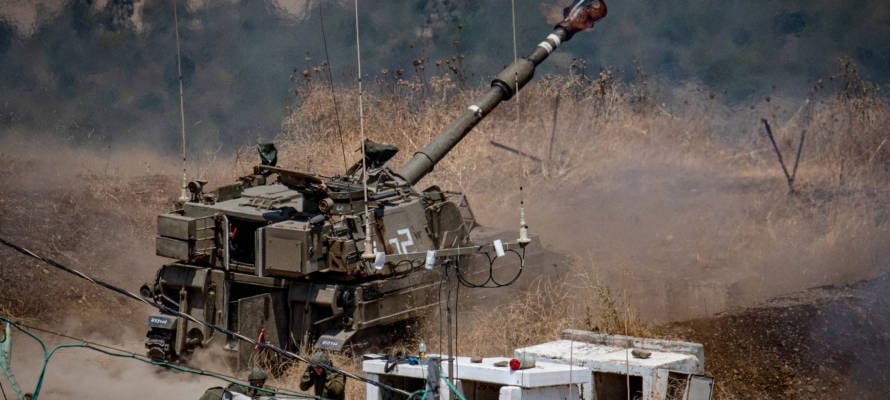Hezbollah has its own drones, which fly into Israeli territory to drop bombs on Israeli positions, so soldiers are asking for special protective netting.
By Asaf Elia-Shalev, JTA
As tensions between Israel and Hezbollah have shot up to new highs, Israeli soldiers anticipating being deployed to the north are increasingly turning for help to the civilian donation efforts that have kept them stocked in Gaza.
Adi Vaxman, who heads the U.S.-based donation effort called Operation Israel, fields requests from individual soldiers and says demand has spiked in tandem with security developments involving Hezbollah.
“With the situation up north, the demand has tripled in the last few days,” Vaxman told the Jewish Telegraphic Agency last week. She said the total requests by soldiers in September are on pace to reach double the roughly 15,000 requests from August.
Civilian volunteers have been working for weeks to better understand the unique needs posed by the intensifying conflict in the north, which is taking place across a different terrain than Gaza and against Hezbollah, a group with more advanced capabilities than Hamas.
After conversations with senior officers involved in military logistics, another civilian effort called the Discretionary Fund for Israel, which is led by Shalem College administrator Daniel Polisar, launched a $8 million fundraising drive earlier this month.
The dollar figure comes from a calculation of what gear is needed — and which kind of items the military has recently procured. Drones, for example, were one of the most requested items from donors for many months, but the military is now distributing them in large numbers, according to Polisar.
In a fundraising email, Polisar warned his donor pool that an escalation in the war was imminent and soldiers were not sufficiently supplied for what’s expected.
“I’m writing at one of the most difficult times Israel has faced since Hamas’s atrocities of October 7 precipitated a multi-front war,” Polisar wrote. “The evolving situation has created grave new risks for the brave men and women defending our country.”
Since the appeal went out, Polisar’s prediction has come much closer to reality. The Israeli cabinet has declared as a war aim the return of 60,000 Israelis displaced from their homes by Hezbollah’s rockets.
Hundreds of pagers have exploded across Lebanon in attacks targeting Hezbollah operatives. Israel assassinated a top Hezbollah commander in an airstrike. Hezbollah chief Hassan Nasrallah declared Israel has “crossed a red line.”
And the Israeli military has redeployed a large fighting division from Gaza to the northern border.
Over the weekend, tensions escalated sharply. Israel battered Hezbollah positions inside Lebanon, including in Beirut far from the border and of a meeting of Hezbollah commanders who Israel said were planning an Oct. 7-style invasion of the north.
Meanwhile, Hezbollah sent dozens of rockets deep into Israeli territory, injuring several and sparking fires in populated areas.
Whether the conflict evolves to include ground fighting remains to be seen.
But Israeli soldiers worrying that any effort to secure the north would necessarily include an invasion have continued to request basic combat items like helmets and ceramic plates for body armor as they have done in Gaza — and donors have begun adding other kinds of equipment as well.
The size of the battlefield in the north is larger than Gaza, which has been characterized by close-quarter urban combat. Drones must fly over longer ranges, which calls for different types of batteries and special antennas, according to Vaxman.
Hezbollah has its own drones, which fly into Israeli territory to drop bombs on Israeli positions, so soldiers are asking for special protective netting.
Weather is also a factor as winter months approach and temperatures drop, especially at high elevations. The uneven topography of northern Israel and southern Lebanon also makes it more difficult for the Israeli army to detect threats, which is why soldiers ask for special surveillance cameras.
Jews in the Diaspora who have been asked repeatedly since Hamas’s attack last October to help buy soldiers combat gear have largely responded with an open checkbook, but they have also expressed alarm about the implication that the military cannot supply itself.
Polisar received a wave of questions reflecting such concerns after his fundraising email and then addressed them in a follow-up message.
His email noted the immense scale of hostilities Israel is facing and praised military leaders for ramping up their purchasing to meet billions of dollars in equipment needs.
“Even so, there are certain critical areas in which the IDF has not fully succeeded in rendering our soldiers as safe and effective as possible in the short time horizons dictated by war-time conditions,” Polisar wrote.
“In a perfect world, the Israeli army would take care of everything, my team and I would not need to raise funds and purchase gear, and I would not be asking you to consider once again stretching your limited resources.”
In another possible sign of how serious the need for more equipment is, earlier efforts by the military to stop the flow of donations to individual units appear to have receded.
In July, the commander of Israel’s ground forces, Tamir Yadai, warned his troops about rules against accepting donations and threatened heightened enforcement. He also called for officers to inventory all donated supplies and confiscate equipment that doesn’t match IDF standards.
Yadai’s order had a chilling effect on donors, who feared that their contributions would go to waste, according to multiple fundraising groups.
Since then, however, Yadai has resigned from the military. And officers are not taking action to stop donations, according to the civilian aid groups.
